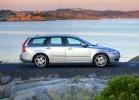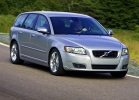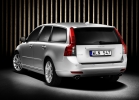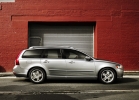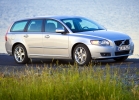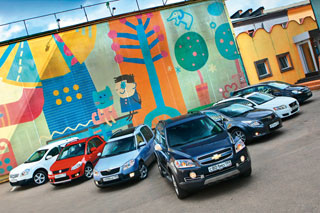VOLVO V50 test drive since 2007
Individualized "clone", or new station wagon from Volvo
The concept of the platform has firmly entered the vocabulary of automotive business professionals. Ten years ago, no one really knew what this word means, and now the most interesting topic is a discussion of models created on the same platform. What is similar, what is different, successful or not in general turned out to be a platform and how many more models can be designed on it ...Naturally, the platform appears much earlier than the car itself. To make it clear to you, we will first explain what can be considered a platform in general. This is nothing more than the base of the car - the floor with power elements, the front and rear spars, the shield of the motor compartment. This also includes pendants and power elements, to which the pendants are attached, although in some cases several cars with different pendants can be produced on one platform. In general, the platform is really a platform on which you can then design differently forms - sedan, hatchback, station wagon, single -collector, SUV, etc.
The platform assumes all the loads, and that is why many parameters of the models created on it depend on how successful it turned out - controllability, toughness of the body for twisting, etc. That is how, by the way, the success of a particular platform is determined - if it turned out to be strong and has high torsion rigidity, then you can make any model on it driver - whether it be a minivan, or hatchback.
Within the framework of the program of total unification of models and reducing the costs of development and launching in production, the platform took root as well as possible. Firstly, the use of a common basis can significantly reduce the terms of car development - after all, designers have to work not from scratch, but from an almost finished chassis. Secondly, a successful platform with suspensions allows you to pay more attention to refinement of handling. If desired, the car can be made more acutely and more interesting for an experienced driver or leave handling at the level of the basic version of the platform - as the client wishes, it will be so.
Finally, thirdly, the platform allows you to create very safe machines. After all, it is the platform that is the main supporting element of the car, and when developing it, designers repeatedly check the entire design for the ability to repay the energy of the impact. And this means that before the car systems are introduced into the car, it is already able to reliably protect passengers - due to the strength of the platform itself, as well as due to its ability to distribute and repay the energy of the impact.
The new Volvo V50 station wagon, as well as the new S40 sedan, are also cars that were designed on a ready -made platform provided by another company. In this case, the Ford concern was the donor, which recently belongs to Volvo - the new owner has provided his new universal platform on which several models have already been created. In particular, the nozzles of the new Volvo S40/V50 family are the new Mazda 3 and the Ford Focus C-Max single-combor.
We noticed how different are these cars? Sports Mazda 3, a compact five -seater universal Ford Focus C -Max and, finally, the hero of our today's test - Volvo V50. All of them belong to different price categories, are intended for different consumer groups, respectively, and the requirements for them are different. The question arises: how different can the cars created on the same platform be?
Very different - I want to answer, looking at the Volvo V50 - at least externally. The Swedish station wagon has absolutely no similarity with either the Japanese hatchback or with the German single -raised. This is a completely original car with a fairly original design made in the Volvo corporate style. By the way, about the style and recognition: you need to be very ignorant in cars by a person, so that, having met V50 in the city, you can’t guess that this is Volvo. The rectangular false radiator grille crossed by the chrome strip for a long time became the hallmark of this brand, and almost everyone seems to know this business card.
Another business card is a pronounced lower back at the window line level. This decision, invented by the chief designer of Volvo, is called the Volvo shoulder - visually, due to the expanded waist line, the car seems larger and more powerful. However, in statics Volvo always looked very well, especially - station wagons. With the sedans of this brand, everything was simple and clear, but the Volvo station wagons are a separate story. That the legendary 245th, that the cult of the 740th, that the charismatic 940th-all of them were a real event. Which, we hope, will be able to become Volvo V50.
Both S40 sedan and V50 station wagon from afar are very much like the older Volvo models - the S60 business sedan and even the flagship S80. Is it good or bad? For the owner of the most affordable Volvo - good, because in the stream his car will often be mistaken for a more expensive model. And how will the owner of the top S80 T6 feel? Of course, any understanding person will quickly see the differences, but not everyone is well versed in cars. And, probably, it will be very disappointing if your new charming acquaintance does not see the difference between the base S40 and the flagship S80 ...
Although not, as soon as this charming is in the cabin, it will definitely feel the difference - inside the V50 is noticeably easier. If the interior were performed in the style of models S60 and S80, it would be a real personification of luxury. I don’t even know why, but in the same S80, even in the simplest version, the interior, thanks to voluminous panels, seems very luxurious-even more luxurious than in Mercedes-Benz S-class. That would be the interior on Volvo V50 ...
But the younger model inside was performed in a completely different style. There is not a wide, laid aside the driver of the panel, nor a voluminous central console - everything is much more modest. A small visor visor, the ignition logging larva next to it and ... and that’s all: the rest of the front panel is nothing interesting.
Although there is also its own chip: the central console is as if suspended between the panel and the facing of the central tunnel. In the profile, the console is very thin - literally one and a half centimeters, and behind it there is a small shelf. Under the order, this same console is proposed in a transparent performance, which is why its appearance is even more futuristic.
We have no complaints about the quality of the finish: everything was collected very well, with minimal gaps and using expensive materials. As they say - simple, but with taste. The seats in the tested machine are comfortable: the abundance of adjustments allows you to get a job as conveniently as possible. By the way, the steering wheel itself was also not bad, it is pleasant to the touch, optimal in diameter, and the shape of the overlay is typically Volvskaya. Only the features of the car configuration were a little surprised: only the cruise control control keys were displayed on the steering wheel. Strange, usually our consumers prefer here to see the remote control keys of the audio system or the Built -in phone control buttons.
Sitting up for the first time behind the wheel of the Volvo V50, you do not have to get used to the car for a long time. The aforementioned convenient seat combined with the driver’s workplace verified by the ergonomics of the driver’s workplace allow you to not engage in settings and adjustments for a long time. The tidy is read very well: there are only two dials and two small screens here. But information on them is displayed enough. On the speedometer field there is a small indicator of fuel level, and on the tachometer there is a temperature sensor. The mileage (general and daily) is displayed on one of the screens, and additional information is displayed on the second.
You can only find fault with the ergonomics of the center: the location of the buttons on the suspended central console looks beautiful, but they need either a habit or visual control. Simply put, the driver needs to look at the console to change the operating mode of separate climate control or change the radio wave. We admit that, when you get used to it, the driver will be able to use the keys blindly, but you need time to get used to it ...
Another important point is small external mirrors. Everyone probably knows how Volvo cares for safety, and therefore it was very strange to see such mirrors on the new model. Moreover, for the same reason - in an effort to increase the safety of cars - Volvo V50 has very powerful front and side roof racks. And this very significantly worsens overview: when leaving the main road, the driver has to look out from behind the side rack, so as not to lose another car. Yes, and there are problems on ordinary turns: windshield racks are also very massive, and this slightly reduces the viewing sector. So small mirrors are a serious drawback for the Volvo V50.
But this car has more advantages ... One of the positive qualities of this car is a sufficient supply of space for the rear passengers. In a three-wing mazda and in the Ford Focus C-Max minivan, the salon turned out to be very spacious, and Volvo, built on the same platform, was no exception. There are enough places behind: the two is very convenient there, and for three it is quite normal. It is strange, however, that there is no central armrest on the back sofa - the car is still not cheap, and they are unlikely to be used as a van. So, perhaps, sometimes to immerse a surf or a mountain bike to service ... But it is still very convenient for passengers, since the rear seat is equipped with three head restraints, a three -point seat belt is provided for each of the riders.
The basic version of the Volvo V50 is equipped with a 1.8-liter 125-horsepower gasoline engine, which is combined with a 5-speed manual gearbox-such a car costs from $ 22.653. The equipment, by the way, is quite rich. The Volvo V50 is equipped in the standard with two frontal and two lateral airbags, as well as special inflatable curtains that protect during lateral clashes. In addition, the station wagon has ABS with the electronic distribution system of brake efforts, the EBA emergency braking system and the safety belts with pretensors. The car in the standard version has 16-inch wheels, moldings are painted in the color of the body, the rear seats are folded in a ratio of 60/40, and the steering column is regulated in height and departure. Air air conditioning airfield, immobilizer, remote control of locks and signaling (with windows closing), external mirrors with electric drive, heating and rotation indicators in them, heating the front seats - this is also a standard equipment.
We had a more expensive version on the test-with a 2.4-liter atmospheric engine with a capacity of 140 hp, a 5-speed automatic gearbox and a large list of additional equipment. But we will not pay attention to the bells and whistles, we will tell you better about the behavior of the Volvo V50.
To begin with, about an engine that coexists with a 5 -speed automatic. Of course, 140 horses and 10.6 seconds from a place to hundreds are not the indicator that they dream of, but even in this version, the Volvo V50 turns out to be a rather driver. Easy acceleration, well -predicted switches of the machine and a rather low level of noise in the cabin - all this creates the illusion of a rapid flight. And the look at the speedometer confirms this: even at 140-150 km/h, the station wagon is comfortable and pleasant to control, moreover, the speed is not felt at all.
I pleased the machine. Even in a drive, without using a manual mode, he adapts very well to your driving manner and is ready for all kinds of surprises. Say, if you drove for a long time at a speed of 40-50 km/h, and then suddenly decided to accelerate sharply (for overtaking, for example), then until you release the gas, the smart machine will keep the program on which you Started acceleration. Moreover, high engine speeds are not a surprise or trouble for him - if necessary, he can bring the tachometer arrow to the red zone. The only thing he does not know how to do is to cool quickly. If you use a kik -down, and then drop the gas and slightly slow down, the machine gun is pretty strongly kicking the car - it on habit turns on an increase in the gear, although the speed has already fallen.
The smoothness of the course can be best described as follows: in general, the car is quite comfortable, but from Volvo you will implicitly expect something more. After all, the entire advertising campaign of this company is built on such slogans that form the form of Volvo as a luxurious, comfortable car, even somewhat elite. And here, in the guise of a sedan and the universal of the younger series, you get almost a GTI model.
The strange love of suspensions for small coating defects is a feature of all the models made on this platform. Recall that before that we went to Mazda 3 in two versions and on the Ford Focus C-Max minivan, and they all demonstrated about the same behavior: comfort on the even coating and trembling on the body when moving along the chopped asphalt. But if for Minivan this is excusable because in its class C-Max is the best manageability, and for the disputed Mazda 3 family, such a feature of the chassis is normal, then from Volvo, we repeat, expect something more.
The Volvo V50 was remembered by its steering control: a clear zero and an adequate increase in reverse effort when deviated from a straightforward trajectory allow not only to drive a car, but to enjoy the trip. This, by the way, is also one of the features of the platform - Mazda 3 and even the Ford Focus C -Max also differ in pleasant, close to the reference, behavior in high -speed turns.
We can say that Volvo is even a little better: it is more comfortable than a treshka, and cleaner than Si-Max in its reactions. True, the fraction of the body characteristic of this platform when passing small asphalt defects remained, but Volvo still rides softer than Mazda 3. Another plus of the Swedish model: after inheriting the excellent handling of the platform, it practically got rid of its one characteristic feature, namely - namely From a tendency to breakdown into the absence of the rear axle when discharging gas on a turn. Volvo, brought up in accordance with the proprietary ideology, is configured for neutral handling with pronounced insufficient rotation.
In general, this time we were convinced that the Ford Platform was not able to greatly affect the originality of Volvo brand cars. Both in design and in running qualities, they remained true to themselves - prestige, stability, security still remain the main and priority directions of the Swedes. Of course, something could be corrected (in particular, try to somehow compensate for the small fluctuations of the body on the irregularities of the road), but in general, the Volvo V50 turned out to be a very interesting, prestigious and high-quality car. And if you compare it with the nozzles, it turns out that among them Volvo took the highest level - it is more expensive, comfortable, prestigious, elegant, after all. However, who would doubt - this is Volvo! Let the smallest ...
Pavel Kozlovsky

